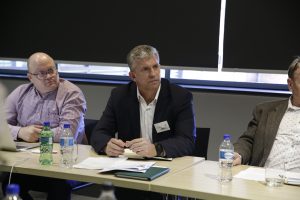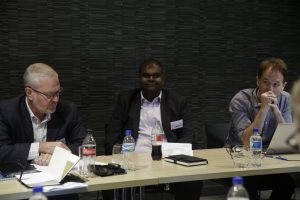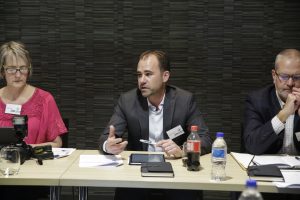Photo above: Boardroom 1953, Omnia House, Epsom Downs, Bryanston
“This week is a better week to meet than last week!” Rain had fallen in several parts of the country, and it was a worthy reminder of how dependent South Africa’s agricultural value chain is on water.
Jan Vermaak was welcoming people to the Omnia Group De-risking agriculture stakeholder roundtable, a discussion held last Friday between leaders within the Omnia Group and leaders from financial institutions like FNB and Nedbank.

Jan Vermaak (centre), Managing Director of Omnia Fertilizer International
A number of questions had been posed before the event: financing difficulties using land as primary source of security; bank frustrations when dealing with farmer profiling for finance (what is good, solid collateral?) Can soil health play a role in de-risking agriculture?
The farmer’s position is perhaps not appreciated by the average citizen. There are no subsidies on offer in the country, and relatively speaking, no help from a government which on one hand champions the role of agriculture to create jobs, earn foreign exchange and stabilise the country, whilst on the other views commercial farmers as an enemy.
Negotiations have been in process for years with government to help with insuring the industry against inclement weather. For now, insurance carries an enormous price tag, and other costs like the country’s biosecurity are increasingly having to be met by the private sector.

Seelan Gobalsamy (centre), CEO of Omnia Group
In some parts of the country rain has not fallen for five years! The entire risk on production is carried by the farmer. Input suppliers still earn money from the transaction with the farmer, but if the weather sabotages the crop, the loss falls entirely on the farmer (no refunds!) For this reason, a sentiment expressed by Gobalsamy was welcome and appropriate: when farmers succeed sustainably, it is might be good business for input suppliers, but it goes beyond this; it is also good for the country and the planet. Look after the people from whom you are making your money!
Vermaak‘s presentation was an overview of the macro environment. Our population is growing but the amount of land remains the same, and most of it is semi-desert. The importance of managing this land correctly is highlighted by the country’s income inequality, which means food cost increases have “very real social impacts”.
Yield boosts have flattened out. Applying too much nitrogen has meant lower returns as well as environmental damage. Precision farming means fertiliser use is more targeted, but “greener” products like biostimulants translate to a more judicious use of fertiliser. Other products improve plant resistance to drought, heat stress, cold stress or water saturation.

Jacques de Villiers, MD of Omnia Fertilizer SA
Precision farming, which prescribes the precise proportion of inputs for optimal yields, featured several times over the course of the afternoon. It certainly was in the foreground of the next presentation.
Jacques de Villiers‘ presentation centred on the role of soil health and good farming practice in bringing relief to high risk profiling of farmers. Technology can indicate the status of a farmer’s soil and, working from this, the likelihood of a good crop can be predicted. Soil health has thus de-risked the farmer’s prospects, and so the producer who is in touch with the soils on the farm is a better position when it comes to negotiating finance and other inputs.

Venessa Moodley, GM of the group’s OmniBio business unit
Venessa Moodley is passionate about soils. They are the basis of life! They have to be the cornerstone of agriculture.
Soil comprises nutrients; physical characteristics like texture and drainage; and biological components such as rhizosphere and root microbiome. These can be balanced with biostimulants, humic acids, fulvic acids, seaweed extracts, microbes, amino acids, vitamins and fertilisers, in right combinations at right times. Read the soil, do the sums and enjoy increased profitability!
People are aware of water scarcity? Good! But if the soils haven’t been attended to, you have runoff and you won’t make the most of the water that is available.
Moodley champions the recently launched Omnia Soil Health Prism, a tool to analyse and make recommendations around the conditions of particular soils. Farmers who use this tool may not understand all the technicalities of soil, but they won’t have to. The prism sharpens their focus and their questions, enabling them to arrive at soil interventions more timeously.
Relevant pages on AgribookDigital include “Soils“, “Fertiliser” and “Speciality fertilisers



